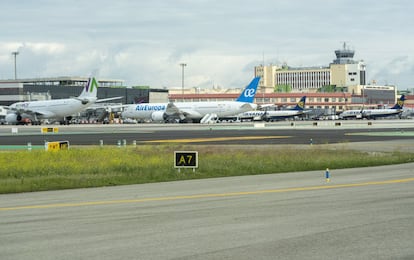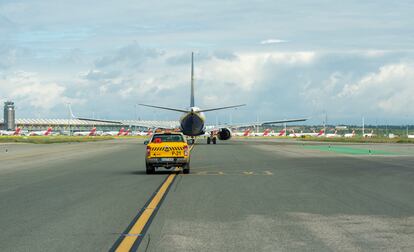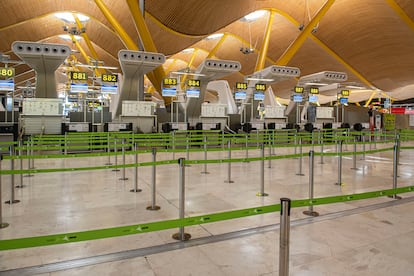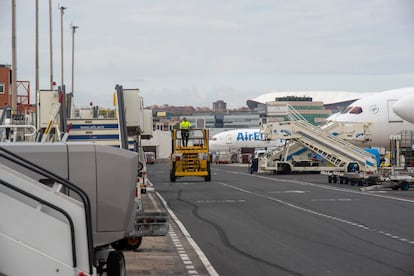Madrid’s Barajas airport under lockdown: A parking lot for 175 planes
Activity at the facility has been reduced to a minimum due to the coronavirus crisis, with daily passenger numbers falling from 170,000 to as little as 500


“What I notice the most is the silence. Before this, it was impossible to keep up a conversation because of the roar of the engines, and you couldn’t even hear the radio station. Now you can hear everything.”
The speaker is Goyo Ruiz del Pozo, the driver of a “follow me” van – vehicles that guide aircraft from the runways to their terminal bays. Ruiz del Pozo, who is 56, has been working at Madrid’s Adolfo Suárez Madrid-Barajas airport for the last 10 years.
On March 23, the Spanish government introduced strict travel restrictions on the country’s ports and airports in a bid to control the coronavirus outbreak. This has led to a dramatic drop in flights and passengers.
“It’s like going to Niagara Falls and suddenly the waterfall stops and all you get is silence,” he says, adjusting his glasses and looking out at the enormous runway on his right. All around him there are dozens of parked airplanes of all sizes.

That is precisely what Barajas has become under the coronavirus lockdown: a gigantic parking lot for the world’s airlines. The planes are everywhere, all 175 of them: sitting close to the terminal, in remote parking areas, and even on the taxiways leading to the runways.
“A lot of airplanes have been parked here because Barajas extends over a large area. That is what allowed us to have over 1,600 operations in a single day for the Champions League [soccer] final last year,” explains Gema Rojas, the highest-ranking official on duty at the airport on Monday.
Keeping an airplane parked at Barajas costs between €700 and €1,800 a day, depending on its weight. The bigger ones pay the highest fees. But AENA, Spain’s airport operator, has delayed payments for six months without interest. Despite being grounded, the airplanes continue to undergo regular maintenance checks every three, seven, 14 and 30 days. This often entails turning on the engines and taxiing around the runways.
“How large is Barajas? If you were to place it on a map end to end, it would take up as much space as the M-30 ring road between the north and the south sections. The runways are four kilometers long,” adds Rojas.

This enormous infrastructure is now barely utilized. On Monday there were only 90 flights, of which 12 were commercial. The destinations were Frankfurt, London, Bangkok, Palma de Mallorca, Tenerife and Fuerteventura. Service between the mainland and the islands is very restricted, and some flights are being used for repatriations.
As for passenger volume, it is down to an average of 3,000 people a day – and even around 500 on a few occasions – compared with last year’s daily average of 170,000. Freight is another good indicator of the drop in activity. In March, the airport received 35,758 tons of goods, a 26.7% drop from the same month in 2019. And a lot of what is coming in is medical supplies, particularly from Shenzhen in China.
It is a highly unusual scene in a normally bustling transportation hub. Barajas contributes 9.3% of the Madrid region’s GDP, and keeps 40,000 direct workers in employment, besides creating around 300,000 indirect jobs across Spain. But this economic engine is now stuck at idling speed.
If the silence of the runways brings a sense of desolation, so does a stroll down the deserted terminals: T1, T2 and T3 are closed to the public due to the lack of flights, and a pharmacy is the only functioning establishment inside T2. “We’re on a reduced working day [from 7am to 5pm] and we mostly serve the few airport employees left. We also take orders to people affected by the coronavirus who live nearby, within the Barajas district,” says Eva Rodríguez, the adjunct manager.

Access to the T4 terminal is only permitted for passengers with a boarding pass for an upcoming flight. Security personnel and National Police officers make sure that nobody else goes in. The vast space, completed in 2006 by the architects Richard Rogers and Estudio Lamela, seems even larger now that it is empty. A couple of employees are busy cleaning, but the baggage carousels are perfectly still and the trolleys are neatly stacked by the dozens at the far end of the room.
“This is all very sad. It saddens me to be like this, and especially not knowing when we’re going to get out of this situation,” says José Luis Prieto, who drives one of the buses that shuttle passengers between terminals. These days, he mostly drives airport personnel and AENA firefighters around. “It’s the uncertainty that’s the hardest to take, and the fact that out of 60 colleagues who normally work here, there are only 12 of us now. The rest have been placed on an ERTE [temporary layoff scheme] and some of them are going through tough times.”
English version by Susana Urra.
Tu suscripción se está usando en otro dispositivo
¿Quieres añadir otro usuario a tu suscripción?
Si continúas leyendo en este dispositivo, no se podrá leer en el otro.
FlechaTu suscripción se está usando en otro dispositivo y solo puedes acceder a EL PAÍS desde un dispositivo a la vez.
Si quieres compartir tu cuenta, cambia tu suscripción a la modalidad Premium, así podrás añadir otro usuario. Cada uno accederá con su propia cuenta de email, lo que os permitirá personalizar vuestra experiencia en EL PAÍS.
¿Tienes una suscripción de empresa? Accede aquí para contratar más cuentas.
En el caso de no saber quién está usando tu cuenta, te recomendamos cambiar tu contraseña aquí.
Si decides continuar compartiendo tu cuenta, este mensaje se mostrará en tu dispositivo y en el de la otra persona que está usando tu cuenta de forma indefinida, afectando a tu experiencia de lectura. Puedes consultar aquí los términos y condiciones de la suscripción digital.
More information
Últimas noticias
Trump claims peace in Ukraine is near, but Moscow suggests otherwise
A survivor’s account of the Interoceanic Train accident: ‘We were scared because of the speed on the curve’
The Interoceanic Train, the Mexican alternative to the Panama Canal
What is known about the Interoceanic Train derailment in Oaxaca
Most viewed
- Oona Chaplin: ‘I told James Cameron that I was living in a treehouse and starting a permaculture project with a friend’
- Reinhard Genzel, Nobel laureate in physics: ‘One-minute videos will never give you the truth’
- Why the price of coffee has skyrocketed: from Brazilian plantations to specialty coffee houses
- Pablo Escobar’s hippos: A serious environmental problem, 40 years on
- Chevy Chase, the beloved comedian who was a monster off camera: ‘Not everyone hated him, just the people who’ve worked with him’








































